So the flowering happened today...
Didn't get a great picture of the flowers. Substantially similar to E Candolleana in longer, not very rounded petals. Early in the day, the petals were folded back, away from the petals, but later, when these were taken, the petals were forward, around the stamens. The flowers did have a scent, enough to easily be sniffable, but not anything like as strong as the Grimal. The scent isn't as nice, either, smelling something like a weaker narcissus with a little honeysuckle sweetness. You could say there is an onion/garlic note, but it's more narcissus.
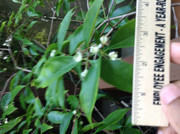
The leaves are a bit like E Candolleana, but they are generally bigger and flatter than E. Candolleana. I took a picture of a leaf that was 10cm in length, and they can go to at least 12.5cm in length.
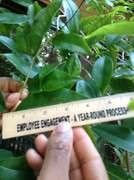
At the bottom, the trunk has zero inclinations to sucker, and the tree seems to actively neglect lower branches in favor of higher branches in a spreading format. The bottom is smooth, with a mottled gold and copper look. As you go up higher it's a stronger reddish copper smoothness, until you hit bark that hasn't flaked off yet. It mostly flakes off rather in chips rather than peels off. Above a point, you have grayish bark with tiny longitudinal ridges, with areas higher that that has flaked off to copper as well.
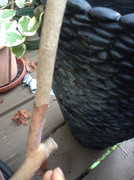
In addition to seeking the sort of tree shape a M. Trunciflora or P. Rivularis tend to want to have, in the lower areas of the bark, you can find fissures. These are smaller than what Adam has shown in the JA thread, and there's no signs of a branch, though I might be able to believe that a branch once existed there. They are hard to see in this image, but the trunk in the forefront has circular patches of copper in the middle of bark area where fissures are, and the background trunk has fissures at the very bottom of the image.
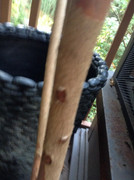
The young leaves have very little red pigmentation that quickly fades. They are shinier than mature leaves, and have no fuzz.
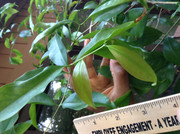
I basically have no real idea what this is, because it seems that most of these genus and species borrow from a very similar set of different ideas, and you generally need to match multiple traits. There is also difficulties in making assumptions, because different subspecies/varietals have have some pretty different features.
So I figure that
1) However unlikely that is, some kind of Stopper from S. Florida? Main problem is that the leaves probably should be highly aromatic, when these are not.
2) Eugenia Candolleana? Tree was got before many people knew about E. candolleana. The leaves are bigger than what Candolleana should be. It doesn't shed bark annually. It grows very much like how a jaboticaba would grow, particularly trunciflora, vexator, etc, and not like any of the Eugenias (at least not the fast growing ones like Candolleana). I also get the sense that Candolleana is more of an upright grower when it gets bigger, rather than the general umbrella, almost weeping shape this tree is.
3) Eugenia florida? It's not supposed to have smooth red skin on the trunk, but this tree does have the sort of maybe rough grayish bark...maybe? The leaves are almost big enough, per Helton, and I suspect this would have been more common than E. candolleana in the 90s.
4) Some kind of Plinia that's much like Rivularis or Trunciflora. Again, leaves are bigger than most known myrtacae, and are certainly bigger than previous mentioned species. It's not grandiflora or aureana.
5) A uvaia with much bigger than normal leaves.

